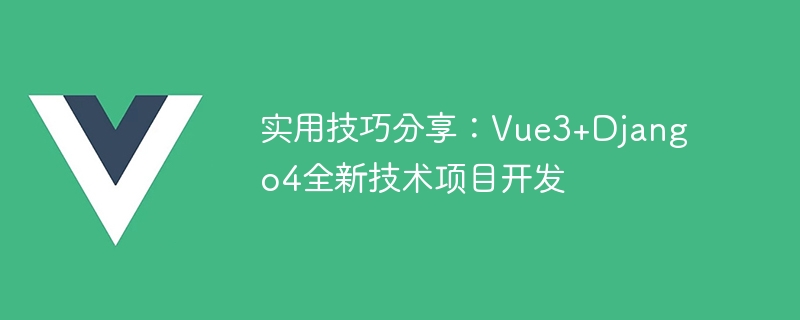

In recent years, front-end technology has developed rapidly, and Vue.js has attracted much attention as an excellent front-end framework. With the official release of Vue.js3 and the upcoming arrival of Django4, combining the two to develop new technology projects is undoubtedly a good solution that can break through technical bottlenecks and improve project development efficiency. This article will share some practical tips to help developers become more comfortable in the development process of Vue3 Django4 technical projects.
First of all, to start a new Vue3 Django4 project, you first need to set up a development environment. The installation of Vue3 has some changes compared to Vue2. You can now use the boot command to create a new project. Install the Vue CLI and create a new project using the following command:
npm install -g @vue/cli vue create my-project
This will automatically create a new Vue3 project and install the dependencies locally.
Next, we need to install Django4, which can be installed using the following command:
pip install Django==4.0.*
After the installation is complete, you can create a new Django project:
django-admin startproject myproject
Next, you need Configure communication between Vue3 and Django4. Since Vue3 and Django4 are two completely independent projects, CORS (Cross-Origin Resource Sharing) needs to be used to handle cross-domain issues. In Django's settings.py file, find and modify the following content:
INSTALLED_APPS = [
...
'corsheaders',
]
MIDDLEWARE = [
...
'corsheaders.middleware.CorsMiddleware',
...
]
CORS_ORIGIN_ALLOW_ALL = TrueIn this way, Django4's cross-domain processing is configured.
Next, we will implement data interaction between Vue3 and Django4. For front-end and back-end interaction, we can use RESTful API. In the Vue3 project, we can use the axios library to make HTTP requests. First, we need to install axios:
npm install axios
Next, add the following code to the main.js file in the Vue3 project:
import axios from 'axios' Vue.prototype.$http = axios
So that you can use axios in the Vue3 project to send requests .
In Django4 projects, we can use Django's class views and serializers to handle requests and responses. First, create a new Django application:
python manage.py startapp myapp
Next, write a class view in the myapp/views.py file to handle the request and response logic. For example, we can create a class view named "HelloView":
from rest_framework.views import APIView
from rest_framework.response import Response
class HelloView(APIView):
def get(self, request):
return Response({"message": "Hello, Vue3+Django4!"})Then, add the following code in the myproject/urls.py file:
from myapp.views import HelloView
urlpatterns = [
...
path('hello/', HelloView.as_view()),
...
]In this way, we have implemented Django4 A simple API interface in .
Finally, let’s implement data interaction between the front and back ends. In the Vue3 project, you can create a new component to send requests and get data. For example, in the Hello.vue file in the Vue3 project:
<template>
<div>
<button @click="getData">获取数据</button>
<p>{{ message }}</p>
</div>
</template>
<script>
export default {
data() {
return {
message: ''
}
},
methods: {
getData() {
this.$http.get('http://localhost:8000/hello/')
.then(response => {
this.message = response.data.message
})
.catch(error => {
console.error(error)
})
}
}
}
</script>In this way, when the button is clicked, the front end will send a request to the back end and get the data.
So far, we have completed the construction of the new Vue3 Django4 technology project and basic front-end and back-end data interaction. During project development, functionality can continue to be expanded based on specific needs. At the same time, both Vue3 and Django4 have brought many new features and improvements. Developers can better master and apply them in project development by studying official documents and reference examples.
To summarize, Vue3 Django4 is a powerful technology combination that can help developers develop technology projects more efficiently. In this article, we share practical tips on setting up a development environment, configuring cross-domain processing, and realizing front-end and back-end data interaction. We hope it will be helpful to developers. In the future, there will be more improvements and new features in Vue3 and Django4, and we can continue to explore and apply them to achieve more powerful projects.
The above is the detailed content of Practical skills sharing: Vue3+Django4 new technology project development. For more information, please follow other related articles on the PHP Chinese website!